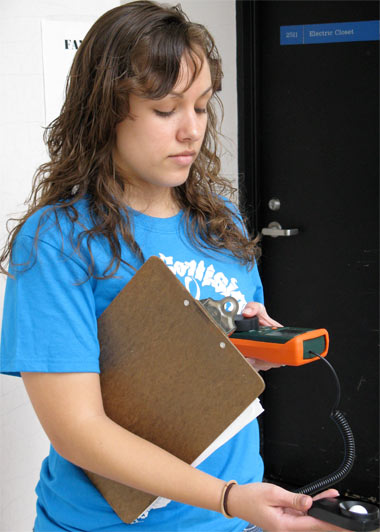
Research Rookie -- Kimberly Elsenbroek, a freshman in the Department of Geography and Environmental Resources from Kingston, uses a light meter to check the levels of lighting in a doorway. She is researching artificial light usage in Faner Hall at Southern Illinois University Carbondale as part of her research project in the new Research Rookies undergraduate research program. (Photo by Andrea Hahn) Download Photo Here
April 22, 2009
‘Research Rookie’ studies building’s lighting usage
CARBONDALE, Ill. -- Have you ever noticed hall lights that are on even though the hall is well lit from a window or doorway? Maybe not, but Kimberly Elsenbroek probably has.
Elsenbroek, a freshman in the Department of Geography and Environmental Resources at Southern Illinois University Carbondale, is conducting a study of lighting usage in Faner Hall on the SIUC campus. Her research will determine how often and where lights are on in Faner Hall when natural light is sufficient, and how much money the resulting unnecessary lights usage costs the University. Elsenbroek is exploring possible cost-and-energy savings measures as a conclusion to her sustainability research project.
Armed with a light meter and lighting blueprints for Faner Hall, Elsenbroek measured the natural light in hallways and doorways in Faner Hall at different times of day, at various points during the year, and in different weather conditions affecting sunshine. She found that some areas of Faner Hall are frequently well lit naturally, with no need for artificial lighting. Her research indicates the University spends approximately $2,500 a year on unnecessary lighting in Faner Hall.
Elsenbroek concluded that a light-sensor system that will automatically turn on or off artificial lighting is the best answer to address unnecessary lighting. Installing such a system is not cheap, she noted, estimating that the payback on the measure would take about 10 years. She is still working on exact numbers and projections as she concludes her research.
Elsenbroek is one of the inaugural Research Rookies. The undergraduate research program, launched this academic year, is designed to engage freshmen in research projects.
Elsenbroek said her early involvement with an in-depth research project enhances the rest of her college curriculum.
“I’m seeing how what I learn in the classroom is applied in research,” she said. “I see how I can use what I’m learning, that it has an application.”
She said that, as a freshman, she felt she didn’t have the experience to select a viable research project, but she knew she wanted her research to focus on an environmental issue.
“I’d heard SIUC was a good school at which to study the environment,” she said, noting that the opportunity to join the University Honors Program and the Research Rookies enhance her enthusiasm about her studies here.
The research project has also brought her into a working relationship with professors and professionals at an early stage in her college career. Elsenbroek worked with electrical engineer Justin Harrell, who helped her read the blueprints, and later in her research, discussed with her various lighting options and state lighting requirements. She also worked closely with Matthew D. Terrell, assistant professor in the geography and environmental resources department.
She already has plans for next year’s project as she continues with the Research Rookies program. She will work with Sara Baer, an assistant professor in plant biology, to study prairie ecology, particularly related to invasive plant species and insecticides.
For more information about Research Rookies, contact Julia Spears, an associate director in the Office of Research Development and Administration, at 618/453-4585 or jspears@siu.edu.
